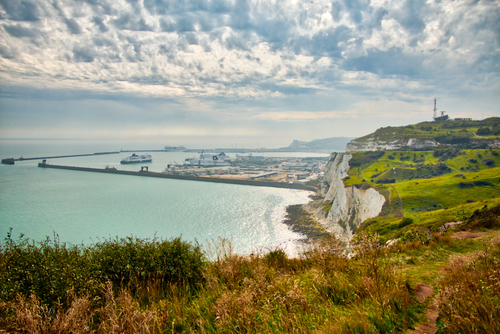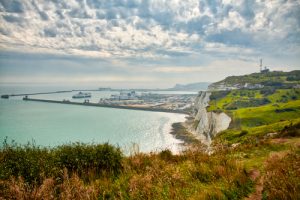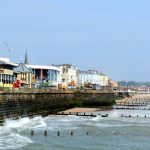
Dover is a Port town and major ferry point in Kent, South East England. It faces the French port of Calais across the Strait of Dover, which at a distance of 21 miles (33 km) is the narrowest part of the English Channel. Dover lies on the banks of the River Dour, situated some 15 miles (23 km) south-east of Canterbury and 8 miles (13 km) north-east of Folkstone. The town is the administrative centre for the Dover District of Kent.
The town is most famed for its chalk cliffs which are commonly referred to as ‘The White Cliffs of Dover’. The cliffs were immortalised in the lyrics of the iconic Second World War song of the same name sung by Dame Vera Lynn. The population of Dover at the 2011 National Census was 32,020.

Image Credit: CharliePhoto/Shutterstock.com
A Fleeting History of Dover
Early Days
The first known inhabitants in the Dover area were Stone Age farmers, who settled in River Dour valley around 6,000 years ago. Dover became a thriving port as early as the first century due to to the Roman occupation of Britain. The town had the advantage of being the closest point to the rest of the Roman Empire, and subsequently, grew rapidly.
Dover became one of the three important Roman towns in Kent, along with Canterbury (Durovernum) and Rochester (Durobrivae). At its peak, the port was thought to cover more than 5 hectares, spread along the Dour valley. The Romans named the town ‘Dubris’ (or Portus Dubris) after the word ‘dubras’, an early Anglo word for ‘waters’.
When the Romans left Britain in the early 5th century, the Jutes, a Germanic tribe, crossed the North Sea to settle in Kent. Dover went on to be known as ‘Dofras’ and become a major settlement in the new Anglo-Saxon Kingdom of Kent. The area’s conversion to Christianity and the founding of Dover Priory occurred sometime in the early 7th century.
It’s also thought by some that a stronghold at the site of the existing Dover Castle may well have been built during the Anglo-Saxon era. While, the Vikings are thought to invaded North Kent around 850, they were never to get as far south as Dover. By the end of the 9th century they had been totally driven out of Kent by Alfred the Great.
Medieval Dover
By the middle of the 10th century, Dover had became prosperous, running its own mint, with well established trading links across the Channel. Around 1050, Dover formed a strategic alliance with four other south coast towns i.e. Hastings, New Romney, Hythe and Sandwich. The organisation was dubbed ”the Cinque Ports”, and as a confederation, made a promise to the crown to provide ships and men for 15 days of the year. This was in return for favourable concessions on taxation and governance.
However, William the Conqueror’s conquest at the Battle of Hastings in 1066 was to mark the end of the Saxon reign and the beginning of the Norman rule of Britain. William soon recognised the town’s strategic importance and quickly made arrangements to fortify Dover Castle. He then appointed a Governor of the Castle, who was also made Lord Warden of the Cinque Ports. In the two decades it took to compile The Domesday Book (1086) for Britain, the perceived value of a revitalised Dover had risen from £18 to £40.
Rebuilding Time
The next century saw Dover almost completely rebuilt, as well as the founding of churches, hospitals and other religious buildings. There is also archaeological evidence to suggest that a brand-new Dover Castle was constructed near St Mary’s in Castro, rather than the old fortress being refurbished. New or revamped, by 1190, the vastly improved Dover Castle, was completed. In 1203, founded by Hubert de Burgh, the Maison Dieu was built as a hospice for pilgrims.
During the First Barons’ War of 1215–17, a coalition of the forces of English nobility and France’s Prince Louis, twice laid siege to Dover Castle in an attempt to overthrow King John. However, the royalist army, led by Hubert de Burgh, repulsed all attempts to take the garrison though it sustained severe damage. Attacks by French forces on Dover continued throughout the 13th century. However, the worst incident came in 1295, when a French raiding party up to 10,000 strong, ran amok in the town, razing most of it to the ground.
The Tudor & Stuart Era
During the times of the English Tudor dynasty, invasion from Europe remained a constant threatened. Henry VIII recognised Dover’s great strategic importance and made great improvements to the areas coastal defences. He also built castles at Deal, Sandown and Walmer to protect the Downs anchorage. Further improvements to the fortification of the area were carried out under the reign of Elizabeth I. However, in April 1580, it was an act of mother nature, rather than England’s European enemies that caused the greatest concern.
An earthquake with an estimated magnitude of up to 5.9 ML struck the Dover Straits. It remains one of the largest ever earthquake events to strike England and resulted in a great deal of devastation. However, the only deaths recorded in England was caused by falling debris from a hospital rooftop in London, which struck two children. According to records, there were also several deaths in Flanders and many more in France.
During the Civil War (1642–1651) Dover declared in favour of the king. However, Dover Castle was captured by local merchant Richard Dawkes accompanied by a small gang for the Parliamentarians early in the conflict. Thus, Dover was to remain in Parliamentary hands throughout almost the whole of the war. Yet, despite the long absence of the crown, when Charles II landed at Dover Beach in 1660, following the restoration of the monarchy, he was reportedly met by a large and welcoming crowd.
Dover in The 1800s
During the 18th century, shipbuilding, rope-making, leather making, brewing and fishing all became well-established industries in the town. In 1788, an act of Parliament saw a Board of Improvement Commissioners formed for Dover, which was made responsible for paving, cleaning and lighting the town’s streets. In 1793, following the French Revolution, France declared war on Britain, making Dover a prime target for attack. Thus, within a short time, work began on improving the town’s defences against naval attack.
From 1779 onwards, the fear of French invasion led to the development of Dover’s defensive Western Heights, which grew to become one of Britain’s largest network of fortifications. Consisting of numerous ditches and forts, it stretched along the coast from Dover Castle. The start of the 19th century saw the town itself become heavily garrisoned in readiness for a naval invasion by the French. Thus, there became an urgent need to find accommodation for a great number of troops and their equipment.
Lead Royal Engineer William Twiss’s solution was to create a series of tunnels that would act as barracks. The tunnel complex was created about 15 m below Dover’s famed cliff tops. In 1803, at the start of the Napoleonic Wars, the first of the troops moved into their new accommodation. At the end of the wars, the tunnels were used for a short period by the Coast Blockade Service (CBS) to combat smuggling. In 1827, the CBS moved their headquarters inland and the tunnels were abandoned for more than a century.
19th Century Dover
Like in many of Britain’s towns and cities, the 19th century brought great change to Dover. In 1812, Crabble Mill was built, which greatly enhanced the local capacity to process grain. A much-needed requirement in order that the ever-growing numbers of military personnel in the town could be suitably fed.
In 1821, the first steamship passenger channel crossing service to Calais started up. In 1844, the South Eastern Railway Company opened their line from London to Dover, via Folkstone, where their channel steamers were docked. In 1861 the London, Chatham and Dover Railway Company built a direct line from London to Dover to connect with their own steamers.
Between the 1830s and 1860s, the town’s docklands underwent a huge redevelopment to cope with the fast-growing maritime traffic. By this time, brewing had became one of the town’s largest non-maritime industries with at least eight large breweries in operation. In 1897, electric trams were introduced to the town, the first such service in the South of England. The 19th century had seen great development in Dover and it’s population had increased correspondingly, i.e. from some 2,000 to around 13,000.
The War Years
During World War One conflict (1914-1918), Dover became one of Britain’s most important military hubs. A huge number of men crossed from Dover on their way to the battlefields of Northern France. The town harbour was of particular importance since it housed a fleet of warships and fishing vessels, known as the ‘Dover Patrol’. The eclectic mix of ships and boats were tasked with protecting Britain’s south coast and keeping control of the channel.
As a consequence, the town became a frequent target for shelling from enemy warships and aerial bombing. Many of Dover’s residents were forced from their homes to shelter in caves and dug-outs. The town became known as ‘Fortress Dover’, eventually, put under martial law.
In the Second World War (1939 – 1945), Dover was again to play a vital role in the war effort. The evacuation of Dunkirk’s beaches in May 1940 was masterminded by the Admiralty based at Dover’s Secret Wartime Tunnels situated beneath the castle. More than 200,000 of the 338,000 men evacuated from Dunkirk’s beaches arrived at Dover.
The town, due to it’s strategic importance, was once again routinely shelled and bombed throughout the course of the conflict. This culminated in 3,059 bomb alerts, the death of 216 civilians, and damage to more than 10,000 buildings, many to be later demolished, throughout the Dover District.
The Modern Era
In 1953, the town’s first two drive-on drive-off ferry berths were opened at Eastern Docks. They handled around 100,000 vehicles in the first year of operation, ten times the anticipated traffic. In 1965, roll-on roll-off freight was introduced to the port, but it handled only a few hundred lorries in the first year. In the late 1960s, due to ever-increasing traffic, work on a third ferry berth began. In 1978, the first commercial hovercraft crossing of the channel began operation from the Western Docks.
When the building of the Channel Tunnel got underway in the late 1980s, the future of Dover’s ferry port looked uncertain. However, following the opening of the Tunnel in May 1994, despite the fears, the ferry traffic has actually grown. In 2005, following further redevelopment, a new ferry terminal was opened by Queen Elizabeth II.
A major portion of Dover’s economy is linked directly or indirectly to its maritime activity. The Port of Dover continues to undergo transformation and growth, and today, handles some 5 million vehicles and 13 million passengers, annually. It’s now Europe’s busiest ferry port, seeing some £120 billion worth of year-on-year trade, 17% of the UK’s total.
Getting to Dover
By Car
Getting to Dover from most of the country by car is straightforward. Just head towards London and then take the M25 circular road. From the M25, turn off for the M20, which will take you all the way to Dover, though it becomes the A20 a few miles short of the town. An alternative, and slightly longer route, is via the M2 and A2.
By Coach
National Express operates a regular coach service from London Victoria Coach Station to Dover. There are 3 buses per day; late morning, mid-afternoon and early evening. The 76 mile (122 km) journey normally takes around 2 hours.
By Train
Getting to get to Dover from most of the country will mean heading to London first. From there, you can take the high-speed South-eastern train from London St Pancras International, which takes a little over an hour. There are also normal speed services from Charing Cross, London Victoria and St Pancras, which takes around 2 hours.
By Air
The nearest airport to Dover is London City Airport, about 60 miles away. It has flights to/from domestic and European destinations only. The nearest major international airport is London Gatwick which is 84 miles away.
By Boat
Dover is one of the busiest cross-Channel ports in the UK. Regular ferry services operate to Dover from Calais and Dunkirk.
Did you know?
- In August 1974, artefacts were recovered from Britain’s earliest known shipwreck, off the coast of Dover. The ship is thought to date back to about 1100 BC.
- Dover Castle has been used as a shooting location for a number of TV productions, including; Doctor Who, The Mind of Evil, Wolf Hall, The Hollow Crown and The Amazing Race.
- Dover’s St Edmund’s Chapel is reputedly the smallest church in England still in regular use. Built in 1262, it’s around 28ft x 14ft (8.5m x 4.25m) with 2ft thick walls.
- Setting off from Dover’s Admiralty Pier on 24 August 1875, Captain Mathew Webb was the first person to swim the English Channel without assistance.
- The first aerial bomb to be dropped on British soil fell near Taswell Street, close to Dover Castle, on Christmas Eve 1914.
Notable People
- Sir Edward Pellew (1757 – 1833) – the 1st Viscount Exmouth, was a famed Royal Naval officer and explorer who was born in Dover. He reached the rank of admiral and fought in the American War of Independence, the French Revolutionary Wars, and the Napoleonic Wars. Some geographical features around the world and a number of UK naval establishments have been named after the naval hero. His character also appears in several books of naval fiction.
- Cuthbert John Ottaway (1850 – 1878) – was an early exponent of football, who was born in Dover. He captained the England team in what is recognised as the world’s first official international football match. The match took place against Scotland at Partick on 30 November 1872, resulted in a 0 – 0 draw. However, Ottoway also represented England at cricket and Oxford university at no less than five different sports – a feat yet to be equalled. Tragically, Ottoway died in 1883, aged only 27 years old, thought to be tuberculous.
- Jocelyn Eve Stoker – was born in Dover on 11 April 1987. Much better known by her stage name of ‘Joss Stone’, she is an English singer, songwriter, and on occasions, an actress. A precocious talent, she has won multiple music awards.
Things to see in Dover
There are lots of great things to see in Dover. Here’s a few recommendations:
- The White Cliffs (of Dover) – can best be viewed from the National Trust’s ‘Gateway to the White Cliffs Visitor Centre’. It offers superb views of some 5 miles of coast, the surrounding countryside, and traffic on the world’s busiest shipping lane. It also has displays about the area, including its flora and fauna.
- Dover Castle – was largely rebuilt and extended in the 11th century by Henry II. However, a stronghold of some kind has stood on the site since Roman times. One of the largest and most historic castles in England, it has guarded the shores of England for 2000 years. The main part of the castle, the Great Tower, is where you’ll find costumed actors recreating medieval life at King Henry`s court.
- Dover’s Secret Tunnels – can only be accessed from Dover Castle, but are an attraction in their own right. The tunnels were dug during medieval times, but have been used by the British armed forces in the country’s defence, right up to World War Two. They have provided shelter, offices, and a makeshift hospital, during times of conflict. There’s an ‘hospital tour and a longer ‘Operation Dynamo tour’, which tells the story of Dunkirk.
- The Roman Painted House – is an ancient ruin built around 200 AD which helps tell the story of Roman Dover. Some of the murals on the walls of what was thought to be a ‘mansio’ (hotel), still survive. The are also some Roman exhibits found in Dover on display.
- Dover Museum – is one of Kent’s oldest museums and premier tourist attractions. The galleries tell the story of the town development throughout its long history, using artefacts, graphics and models. There’s also exhibitions on the German cross-channel shelling campaign in the WW2, cross-channel swims and Louis Blériot’s first flight across the Channel in 1909. However, the star exhibition is a 3600-year-old Bronze Age boat, discovered near to the town during road excavation works in 1992.
- Pines Gardens – are located at St. Margaret’s Bay, just four miles from Dover. They consist of 6 acres of eco-friendly estate that includes a small waterfall and an adjoining lake. There’s also a grass labyrinth, an organic kitchen garden, a tearoom, and a conference centre and wedding venue, on site.
Things to do in Dover
A few things to consider doing in and around Dover are:
- Samphire Hoe Country Park – is just two miles west of Dover and was created using chalk that was excavated during the construction of the Channel Tunnel. There are designated areas for walking, cycling, and bird watching.
- Bluebird Market – has a variety of stalls offering local fresh produce, including fresh fish, seafood, cheeses and fresh vegetables. There’s also a range of the usual market bric-a-brac, gifts and hardware. The market takes place every Tuesday between 9 am and 2 pm.
- Coast to Cathedral Cycling – is a 50 mile (80km) route from Dover, that takes you through scenic countryside and picturesque small hamlets, to the cathedral city of Canterbury. The route is almost traffic-free between Dover and Whitfield, where it then joins a network of quiet country lanes towards Canterbury.
Where to stay?
There’s a decent choice of accommodation in and around Dover though inns and guesthouses form the most common types. A broad price guide for accommodation per night in and around the town for 2 adults sharing is:
Inn/B & B/Guesthouse/Lodge/Hotel: £50 – £90
Luxury Hotel: £90 – £150
Thinking of moving?
Are you thinking of moving to Dover? Over the last 12 months, properties in Dover have fetched an overall average price of £208,400. The best selling properties in the last year were terraced houses, selling for an average price of £179,400. Flats sold for an average of £128,000, semi-detached properties for £236,200, with detached properties fetching £321,000. Overall, the average property in Dover, in the last 12 months, sold for 2% less than in the previous year.



